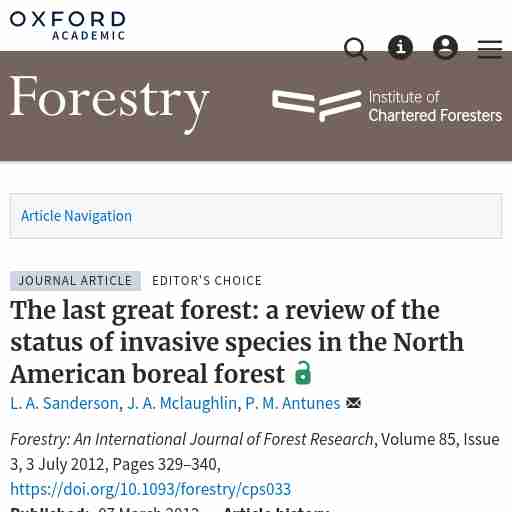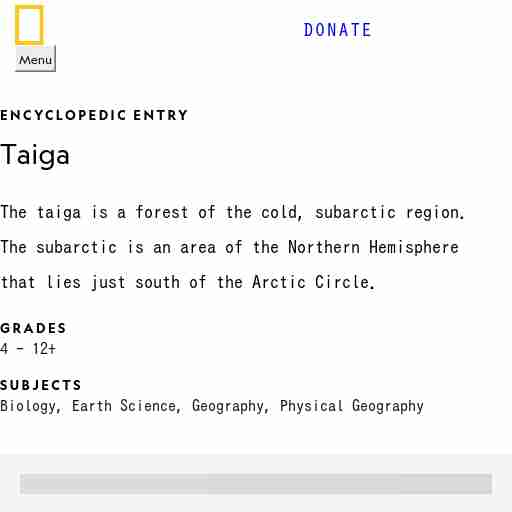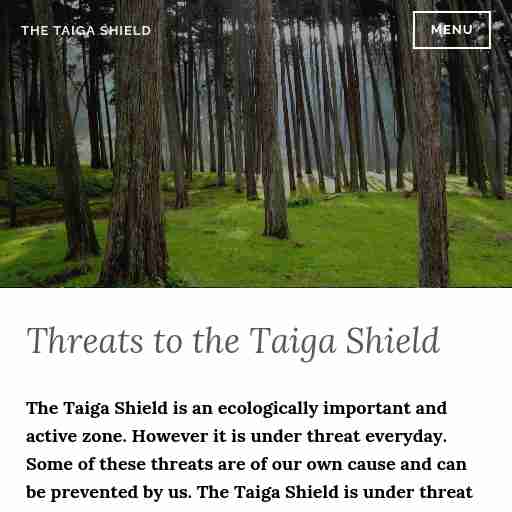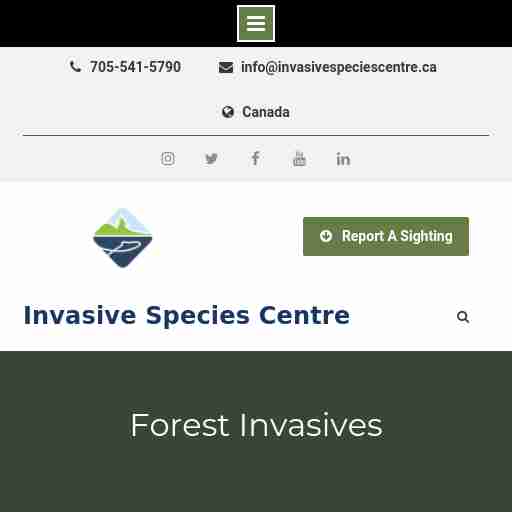Taiga Invasive Species: Threats and Consequences for Boreal Forests
A. Definition of taiga and its importance
The
taiga, also known as the
boreal forest, is the world's largest land biome, spanning across North America, Europe, and Asia. Taiga forests are characterized by their cold climates, short growing seasons, and coniferous tree species like pines, spruces, and firs[^1^]. These unique ecosystems play a crucial role in global climate regulation through carbon sequestration and serve as home to a diverse range of flora and fauna.
B. Overview of invasive species
Invasive species are non-native organisms that cause ecological or economic harm when introduced to a new environment[^2^]. Invasive species can be plants, animals, or microorganisms, and they often spread rapidly due to a lack of natural predators or competitors. Invasive species can negatively impact native ecosystems by outcompeting native species for resources, altering habitat structure, and disrupting natural processes.
C. Significance of studying taiga invasive species
Studying invasive species in the taiga is essential to understand their potential impacts on these fragile ecosystems and develop effective conservation and management strategies. Invasive species may threaten the taiga's biodiversity, disrupt ecosystem services, and have socio-economic consequences for local communities and industries.
A. Major taiga invasive species
1. Invasive plant species
a. Description and origin of each species
Several invasive plant species pose a threat to taiga ecosystems. Some of the most concerning species include:
Purple loosestrife (Lythrum salicaria): Native to Europe and Asia, this wetland plant was introduced to North America in the 1800s[^3^]. Purple loosestrife forms dense stands, displacing native plants and altering wetland habitats.
Reed canarygrass (Phalaris arundinacea): Originally from Eurasia, reed canarygrass is an aggressive wetland grass that can outcompete native vegetation and reduce biodiversity[^4^].
Giant hogweed (Heracleum mantegazzianum): This large, toxic plant from the Caucasus region can cause severe skin burns and blindness[^5^]. Giant hogweed can also form dense stands, displacing native plants and increasing soil erosion.
b. Impacts on native flora and ecosystem
Invasive plant species can have multiple effects on taiga ecosystems:
Outcompeting native plants for resources such as light, water, and nutrients, leading to a decline in native plant populations[^6^].
Altering soil chemistry, nutrient cycling, and hydrology, which can negatively affect native plants and other organisms.
Disrupting native plant-pollinator relationships, which can have cascading effects on the entire ecosystem.
2. Invasive animal species
a. Description and origin of each species
Invasive animal species of concern in the taiga include:
American mink (Neovison vison): Native to North America, the American mink was introduced to Europe and Asia for fur farming[^7^]. Escaped or released minks have established feral populations, preying on native birds, mammals, and amphibians.
Red fox (Vulpes vulpes): The red fox has expanded its range into the taiga due to human activities and climate change[^8^]. Foxes can prey on native small mammals and birds, potentially affecting their populations.
Gypsy moth (Lymantria dispar): Native to Europe and Asia, the gypsy moth was accidentally introduced to North America in the 19th century[^9^]. Gypsy moth caterpillars can defoliate large areas of forest, potentially affecting tree health and altering forest structure.
b. Impacts on native fauna and ecosystem
Invasive animal species can cause various negative effects on native fauna and the taiga ecosystem:
- Preying on native species, leading to population declines and potential extinctions.
- Competing with native species for food, shelter, and other resources, which can alter population dynamics and community structure.
- Introducing diseases and parasites that can affect native species' health and survival.
B. Pathways of introduction
1. Human-mediated introductions
a. International trade
Global trade in goods and commodities has facilitated the accidental transport of invasive species to new regions[^10^]. For example, shipping containers, cargo, and packing materials can harbor invasive species and transport them across international borders.
b. Accidental transport
Invasive species can also be accidentally introduced through various human activities. Vehicles, machinery, and recreational equipment can inadvertently carry invasive species, while the release of exotic pets or ornamental plants can also lead to the establishment of invasive populations[^11^].
c. Intentional introductions
Some invasive species have been intentionally introduced for purposes such as biological control or as a source of food or income. These introductions can have unintended consequences when the introduced species becomes invasive and negatively impacts native ecosystems[^12^].
2. Natural range expansions due to climate change
a. Shifts in species distributions
Climate change can cause shifts in species distributions, with some species expanding their ranges into the taiga as temperatures increase[^13^]. These range expansions can lead to new species invasions, potentially threatening native ecosystems.
b. Implications for the taiga biome
As climate change continues, the taiga biome may become more susceptible to invasive species, both through range expansions and increased human activity. Understanding these dynamics is crucial for predicting and managing the impacts of invasive species on taiga ecosystems.
C. Ecological impacts of invasive species in the taiga
1. Alteration of nutrient cycling and soil properties
Invasive species can change nutrient cycling and soil properties in the taiga, affecting the entire ecosystem. For example, invasive plants may alter soil nutrient availability or pH, while invasive earthworms can accelerate decomposition rates and modify soil structure[^14^].
2. Modification of habitat structure
Invasive species can also modify taiga habitat structure, potentially affecting native species' distribution and abundance. For example, invasive plants can form dense stands that shade out native plants or alter wetland hydrology, while invasive animals can alter vegetation through herbivory or burrowing[^15^].
3. Disruption of native species interactions
a. Competition for resources
Invasive species can compete with native species for resources such as food, water, and shelter. This competition can lead to declines in native species populations and shifts in community composition[^16^].
b. Predation and herbivory
Invasive predators can prey on native species, leading to population declines and potential extinctions. Invasive herbivores, such as insects or mammals, can also negatively impact native plant populations through feeding[^17^].
c. Disruption of mutualistic relationships
Invasive species can disrupt mutualistic relationships between native species, such as plant-pollinator or plant-mycorrhizal associations. These disruptions can have cascading effects on the entire ecosystem[^18^].
D. Impacts on ecosystem services
1. Carbon sequestration and climate regulation
Invasive species can affect the taiga's ability to sequester carbon, a critical ecosystem service in mitigating climate change. For example, invasive plants may have different rates of carbon uptake than native species, while invasive insects or pathogens can damage trees, reducing their carbon storage capacity[^19^].
2. Water regulation
Invasive species can also alter the taiga's water regulation by modifying soil and vegetation properties. Changes in plant community composition, evapotranspiration rates, or soil hydrology can affect water storage, runoff, and the availability of water for native species[^20^].
3. Provisioning services
Invasive species can impact the provisioning services provided by the taiga, such as timber and non-timber forest products. Invasive plants or insects can damage or kill trees, reducing timber yields, while invasive animals can deplete populations of game species or non-timber forest products like berries and mushrooms[^21^].
E. Socio-economic impacts of taiga invasive species
1. Effects on forestry and timber industries
Invasive species can negatively affect the forestry and timber industries by reducing timber quality and quantity. For example, invasive insects like the gypsy moth can cause widespread defoliation, which can reduce tree growth and ultimately affect timber production[^22^].
2. Impacts on local communities and indigenous populations
a. Loss of traditional resources
Invasive species can impact local communities and indigenous populations by reducing the availability of traditional resources like game animals, fish, or plant materials. These losses can affect cultural practices, food security, and livelihoods[^23^].
b. Altered cultural practices
The presence of invasive species can also alter cultural practices, as communities may need to adapt to changing resource availability or new management practices. This can result in the loss of traditional knowledge and practices, further affecting community resilience[^24^].
3. Economic costs associated with control and management
The economic costs associated with invasive species control and management can be substantial. These costs include expenditures on prevention, early detection, and control measures, as well as the lost productivity and revenue from affected industries and ecosystems[^25^].
F. Management and control strategies
1. Prevention and early detection
a. International cooperation and regulation
Preventing the introduction of invasive species is a critical component of invasive species management. International cooperation and regulation can help reduce the risk of invasive species introductions through measures like import restrictions, quarantine protocols, and risk assessments[^26^].
b. Community engagement and education
Engaging local communities in prevention and early detection efforts can improve the likelihood of successfully identifying and responding to new invasive species. Education and outreach programs can raise awareness of invasive species and their impacts, encouraging community members to report sightings and participate in control efforts[^27^].
2. Control and eradication
a. Mechanical and manual control
Mechanical and manual control methods involve the physical removal or destruction of invasive species. These methods can include hand-pulling, mowing, or cutting invasive plants, trapping or hunting invasive animals, or using barriers to prevent their spread[^28^].
b. Chemical control
Chemical control methods use herbicides, pesticides, or other chemical agents to control invasive species populations. The choice of chemical and application method should be carefully considered to minimize non-target impacts and environmental risks[^29^].
c. Biological control
Biological control involves the use of natural enemies, such as predators, parasites, or pathogens, to suppress invasive species populations. While biological control can be an effective and environmentally friendly option, it is essential to carefully evaluate potential biocontrol agents' risks and benefits[^30^].
3. Habitat restoration
Habitat restoration aims to re-establish native plant and animal communities in areas affected by invasive species[^31^]. This can be achieved through planting native plants, releasing native animals, or supporting the natural recovery of native species populations.
b. Promotion of ecosystem resilience
Promoting ecosystem resilience is a key aspect of habitat restoration. This can involve managing and conserving habitat connectivity, ensuring genetic diversity in native species, and implementing adaptive management strategies to respond to changing environmental conditions[^32^].
III. Conclusion
A. Summary of key findings
Invasive species in the taiga pose significant ecological and socio-economic threats, impacting native flora and fauna, ecosystem services, and local communities. Pathways of introduction include human-mediated introductions and range expansions due to climate change. Effective management of taiga invasive species requires a combination of prevention, control, and restoration strategies.
B. Importance of addressing the issue of invasive species in the taiga
Addressing the issue of invasive species in the taiga is crucial for preserving these unique and fragile ecosystems, protecting the ecological, economic, and cultural values they support. As climate change and human activities continue to reshape the taiga, understanding and managing invasive species will become increasingly important.
C. Call to action
Efforts to address invasive species in the taiga should focus on strengthening international cooperation and policy, engaging local communities and stakeholders, and promoting research and innovation in management strategies. By working together, we can better protect and preserve the taiga biome and its essential ecological services.
D. Future outlook
Challenges and opportunities in addressing taiga invasive species will continue to evolve in a changing world. As global temperatures rise and human activities expand, the taiga will face new threats from invasive species. However, by understanding these challenges and fostering adaptation and resilience in taiga ecosystems, we can work towards a more sustainable future for these critical boreal forests.
Related Links:
https://academic.oup.com/forestry/article/85/3/329/613586

Abstract. The boreal forest is the world's largest terrestrial biome, covering all continents in the northern hemisphere. Much research has focused on the ... JOURNAL ARTICLE EDITOR'S CHOICE The last great forest: a review of the status of invasive species in the North American boreal forest L. A. Sanderson, J. A. Mclaughlin, P. M. Antunes Published: 07 March 2012 Article history The boreal forest is the world’s largest terrestrial biome, covering all continents in the northern hemisphere. Much research has focused on the effects of forest management and climate change on biodiversity and ecosystem level processes of the boreal forest. However, even though climate change and the increasing rate of resource exploitation are likely to intensify the arrival and establishment of exotic species with the potential to become invasive, the boreal forest continues to be viewed as inhospitable to incoming species and we have little understanding of its invasive species status. We reviewed the literature and compiled information on the current status of invasive species across all taxa present in the North American boreal forest. We found that an increasing number of exotic plants, insects, earthworms, slugs and pathogens are establishing in the boreal forest. Research is scarce and their ecological effects are poorly understood. However, given that some of the reported species represent a major driver of change in many ecosystems globally, we expect that this review will provide direction for invasive species research as well as preventative measures aimed at better understanding and conserving Earth’s largest terrestrial biome. The boreal forest is the world’s largest terrestrial biome, covering all continents in the northern hemisphere between the latitudes of 50° and 60°. Representing nearly 25 per cent of the world’s forest canopy, the boreal forest provides habitats for a wide variety of organisms (Chapin and Danell, 2001) and plays a key role in regulating the planet’s most important biogeochemical cycles (Volney and Fleming, 2000). The boreal forest is also a key factor economically with an estimated value of $37.5 billion (Canadian) across all products extracted from the Canadian boreal forest annually. Moreover, an assessment of Canadian non-marketable ecosystem goods and services was in the order of $93.2 billion (Anielski and Wilson, 2003).
https://education.nationalgeographic.org/resource/taiga/

Oct 19, 2023 ... The taiga is a forest of the cold, subarctic region ... Non-native species can sometimes cause economic or environmental harm as an invasive ... The taiga is a forest of the cold, subarctic region. The subarctic is an area of the Northern Hemisphere that lies just south of the Arctic Circle. Biology, Earth Science, Geography, Physical Geography The taiga is a forest of the cold, subarctic region. The subarctic is an area of the Northern Hemisphere that lies just south of the Arctic Circle. The taiga lies between the tundra to the north and temperate forests to the south. Alaska, Canada, Scandinavia, and Siberia have taigas. In Russia, the world’s largest taiga stretches about 5,800 kilometers (3,600 miles), from the Pacific Ocean to the Ural Mountains. This taiga region was completely glaciated, or covered by glaciers, during the last ice age. The soil beneath the taiga often contains permafrost—a layer of permanently frozen soil. In other areas, a layer of bedrock lies just beneath the soil. Both permafrost and rock prevent water from draining from the top layers of soil. This creates shallow bogs known as muskegs. Muskegs can look like solid ground, because they are covered with moss, short grasses, and sometimes even trees. However, the ground is actually wet and spongy. Taigas are thick forests. Coniferous trees, such as spruce, pine, and fir, are common. Coniferous trees have needles instead of broad leaves, and their seeds grow inside protective, woody cones. While deciduous trees of temperate forests lose their leaves in winter, conifers never lose their needles. For this reason, conifers are also called “evergreens.”
https://thetaigashield.wordpress.com/threats-to-the-taiga-shield/

Invasive species such as the Emerald Ash Borer Beetle are significant threats to the Taiga Shield. These beetles destroy vast swaths of forest that is ... This is most likely due to a failure from the backend response. Please contact your technical account manager. The Taiga Shield is an ecologically important and active zone. However it is under threat everyday. Some of these threats are of our own cause and can be prevented by us. The Taiga Shield is under threat from: logging, The Taiga Shield possess vast forests of trees, which is often exploited for lumber. If sustainable logging practices are not enforced than the Taiga Shield is under threat of ecological collapse without the necessary forest to preserve and support the eco-region. Mining is also a threat to the Taiga Shield, as some types of mining create vast deep shafts which cannot be restored to its original form. Dams are also a threat. Blocking the flow of water disturbs water levels, stops organisms in the water from swimming, and affects the land as excavation of the land is also required. An additional threat to the Taiga Shield are invasive species. Invasive species such as the Emerald Ash Borer Beetle are significant threats to the Taiga Shield. These beetles destroy vast swaths of forest that is unaccustomed to surviving. Although the Emerald Ash Borer has not reached the Taiga Shield yet, the rising temperatures in Canada due to climate change will increase the likelihood of the Ash Borer will reach the Taiga Shield. Another threat to the Taiga Shield is pollution. Some essential waterways in the Taiga Shield have been contaminated poisoning some rivers and the organisms inside. Acid rain which is created when rain clouds are contaminated with high levels of carbon dioxide can damage some areas of the Taiga Shield and other organisms. Carbon dioxide levels have been on the rise with the air pollution created by human beings. An additional concern towards the Taiga Shield is hunting legal or illegal. Many organisms in the Taiga Shield are endangered such as the grizzly bear and hunting causes numerous problems. The illegal hunting of the endangered species itself, or in some cases the legal hunting of the endangered species prey. With less prey, the endangered species will have less food to support itself which may result in a decrease to an already low population. Another intriguing threat is climate change to specific animals. With rising heat levels the internal biological clock, or the circadian clock but on a much longer span, are influenced and changed because of the rise in heat. For example some salmon spawn based on the level of heat and with rising temperature then salmon will be unable to spawn. Additionally high temperatures results in evaporation and lower water levels which makes it difficult for salmon to return to their spawning grounds and considering the fact that salmon die once they finish spawning, a population crash is inevitable.
https://www.invasivespeciescentre.ca/forest-invasives/

Invasive Insects · Sirex Woodwasp · Hemlock Woolly Adelgid. 705-541-5790 info@invasivespeciescentre.ca Canada Instagram Twitter Facebook YouTube LinkedIn Developed by the Invasive Species Centre, Forest Invasives Canada provides information and news on invasive insects, pathogens, and plants in Canada’s forests. This site examines the science behind invasive species in Canada, connects visitors to the most recent management information, and addresses the overall threat of invasive species in our forests. Invasive Species Action Fund supports local community groups for on-the-ground action in Ontario Ontario Protecting Environment from Harmful Invasive Species Managing Invasive Insects and Pathogens Protecting Canada’s land and water from invasive species Invasive Fish and Invertebrates Instagram Twitter Facebook YouTube LinkedIn Invasive Fish and Invertebrates Invasive Land Animals and Invertebrates Invasive Species Risk Assessment Economic Impacts to Canada’s Agricultural Sector Economic Impacts to Canada’s Forest Sector Best Management Practices Database Municipal Community of Practice Ontario Phragmites Action (OPA) program Teaching about Invasive Species Invasive Species Awareness Week



